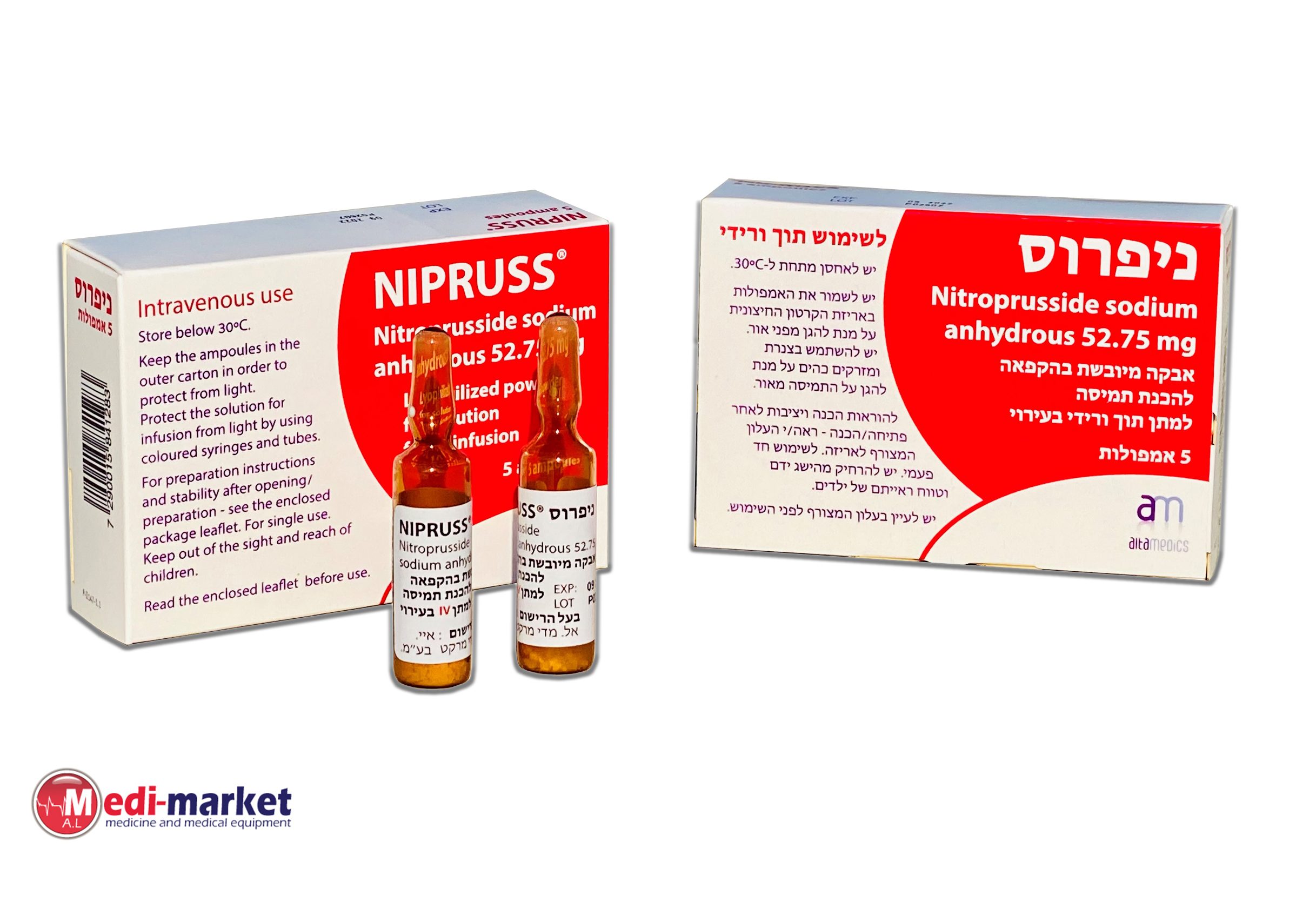Quest for the right Drug

ניפרוס NIPRUSS ® (NITROPRUSSIDE SODIUM ANHYDROUS)
תרופה במרשם
תרופה בסל
נרקוטיקה
ציטוטוקסיקה
צורת מתן:
תוך-ורידי : I.V
צורת מינון:
אבקה להכנת תמיסה לאינפוזיה : POWDER FOR SOLUTION FOR INFUSION
עלון לרופא
מינוניםPosology התוויות
Indications תופעות לוואי
Adverse reactions התוויות נגד
Contraindications אינטראקציות
Interactions מינון יתר
Overdose הריון/הנקה
Pregnancy & Lactation אוכלוסיות מיוחדות
Special populations תכונות פרמקולוגיות
Pharmacological properties מידע רוקחי
Pharmaceutical particulars אזהרת שימוש
Special Warning עלון לרופא
Physicians Leaflet
Posology : מינונים
4.2 Posology and method of administration Posology Sodium nitroprusside infusions generally have to be started with low doses. The hypotensive effect is immediate. Baseline values are rapidly achieved after the end of the infusion. In the titration phase, an exact titration with blood pressure measurements every one to two minutes is required. Towards the end of the infusion, the infusion rate is gradually reduced. The infusion is started at a dose of 0.2 µg/kg/min sodium nitroprusside dihydrate and is then doubled every 3-5 minutes until the desired blood pressure level is achieved. The infusion rate varies between 0.2 µg/kg/min and 10 µg/kg/min sodium nitroprusside dihydrate (see Table 1). To achieve controlled hypotension during surgical procedures, it is recommended not to exceed the total amount of 1.0 to 1.5 mg/kg sodium nitroprusside dihydrate per case. In case of infusions administered over several days, e.g. for the treatment of hypertensive crises, the maximum doses of Nipruss stated above are generally exceeded. To prevent cyanide intoxication, the standard 10% sodium thiosulfate solution at a ratio of 1 : 10 (sodium nitroprusside : sodium thiosulfate) according to the weights of the active substances must be infused simultaneously via a separate venous access (volume ratio: see Table 2). Table 1: Dosage table for perfusor (1.2 mg/mL sodium nitroprusside dihydrate) µg/kg/min Infusion rate [ml/h] sodium nitro- prusside dihydrate Body weight (kg) 30 35 40 45 50 55 60 65 70 75 80 85 90 95 100 0.2 0.3 0.4 0.4 0.5 0.5 0.6 0.6 0.7 0.7 0.8 0.8 0.9 0.9 1.0 1.0 0.4 0.6 0.7 0.8 0.9 1.0 1.1 1.2 1.3 1.4 1.5 1.6 1.7 1.8 1.9 2.0 0.8 1.2 1.4 1.6 1.8 2.0 2.2 2.4 2.6 2.8 3.0 3.2 3.4 3.6 3.8 4.0 1.0 1.5 1.8 2.0 2.3 2.5 2.8 3.0 3.3 3.5 3.8 4.0 4.3 4.5 4.8 5.0 1.6 2.4 2.8 3.2 3.6 4.0 4.4 4.8 5.2 5.6 6.0 6.4 6.8 7.2 7.6 8.0 3.2 4.8 5.6 6.4 7.2 8.0 8.8 9.6 10.4 11.2 12.0 12.8 13.6 14.4 15.2 16.0 5.0 7.5 8.8 10.0 11.3 12.5 13.8 15.0 16.3 17.5 18.8 20.0 21.3 22.5 23.8 25.0 6.4 9.6 11.2 12.8 14.4 16.0 17.6 19.2 20.8 22.4 24.0 25.6 27.2 28.8 30.4 32.0 10.0 15.0 17.5 20.0 22.5 25.0 27.5 30.0 32.5 35.0 37.5 40.0 42.5 45.0 47.5 50.0 Prevention of cyanide intoxication To effectively prevent cyanide toxicity of Nipruss, sodium thiosulfate must always be administered simultaneously as a continuous infusion. Concerning the practical procedure, it is recommended to draw up 10% sodium thiosulfate pentahydrate solution into a second Perfusor syringe and to infuse it at a volume ratio of 10:1 (Nipruss: sodium thiosulfate· 5 H2O) via a separate venous access. When using an Infusomat for Nipruss, the volume ratio should be 50 : 1 or 100 : 1 (see Table 2 below). Table 2 (see section 6) Nipruss dosage using Dosage sodium thio- sulfate 10% Perfusor in 50 ml Infusomat in 250 ml Infusomat in 500 ml Perfusor 0.3 – 10.0 ml/h 1.5 – 50.0 ml/h 3 - 100 ml/h 1 ml/h 10.1 – 20.0 ml/h 50.5 – 100.0 ml/h 101 - 200 ml/h 2 ml/h 20.1 – 30.0 ml/h 100.5 – 150.0 ml/h 201 - 300 ml/h 3 ml/h 30.1 – 40.0 ml/h 150.5 – 200.0 ml/h 301 - 400 ml/h 4 ml/h 40.1-50.0 ml/h 200.5-250.0 ml/h 401-500 ml/h 5 ml/h Thiocyanate toxicity If Nipruss is infused over several days, thiocyanate levels must be monitored especially in renally impaired patients and must not exceed 6 mg/100 mL. Thiocyanate concentrations of more than 6 mg/100 mL lead to toxic symptoms such as weakness, vomiting, dizziness and tinnitus. In cases of thiocyanate intoxication, the infusion of sodium nitroprusside should be discontinued and, if necessary, thiocyanate should be removed from the body with the help of dialysis. Special dosage instructions Patients with hepatic impairment Because the cyanide, which is released from sodium nitroprusside, is mainly metabolized by hepatic enzymes, it may accumulate in patients with severe hepatic impairment. Nipruss should therefore be used with caution in patients with hepatic impairment, and dose titration must be done carefully. In patients with hepatic impairment, signs of cyanide toxicity should be monitored more closely (see section 4.8). Patients with renal impairment If Sodium Nitroprusside is infused over several days, thiocyanate levels must be monitored especially in renally impaired patients and must not exceed 6 mg/100 mL. Elderly patients Elderly patients frequently require lower doses. Children and adolescents No special reduction in the dosage is required. Method of administration Intravenous use: Nipruss is infused intravenously via a Perfusor or Infusomat. Among others, the duration of application is based on the total dose – see information in sections 4.4 and 4.9. Precautions to be taken before and during handling or administering the medicinal product Protection from light can be achieved by using coloured syringes and tubes. For information on the shelf life of the ready-to-use solution for infusion, see section 6.3. The solution for infusion is light yellow in colour. Strongly coloured solutions for infusion must not be used. Additional drugs must not be added to the ready- to-use solution for infusion . The safest way to administer the solution for infusion is via a separate venous catheter to prevent an accumulation of active substances in the tube system or in peripheral veins. For instructions on reconstitution and dilution of the medicinal product before administration, see section 6.6.

שימוש לפי פנקס קופ''ח כללית 1994
לא צוין
תאריך הכללה מקורי בסל
לא צוין
הגבלות
לא צוין
מידע נוסף
